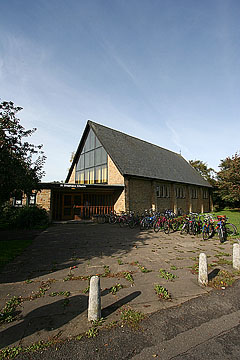In a certain mood, I like walking the suburbs of Cambridge. I don’t know why – like all suburbs, there’s not much of interest and a lot that’s depressing. In the centre of the city it’s easy to be dazzled by beauty and prosperity, and it’s easy to forget that there’s deprivation here too. Around the edges of Cambridge, in Arbury and King’s Hedges and down here in Romsey are large council estates, the houses bunched close together and built as cheaply as possible. It’s a good way of reminding myself about anger, and of dispelling the glamour of the University. What price scholarship and luxury, I ask myself?
Ah – I sound like a tourist and a prig. While I’m at it, I might as well admit a deep streak of sentimentality. I like this sort of urban landscape because I grew up somewhere very similar in Greenwich, and I like being reminded of home. If I’m feeling particularly in need of a nostalgia fix, I’ll wander out this way and hum songs by The Smiths or poems by Philip Larkin to myself. Lots of melancholy fun.
What, I hear you ask, is the point of such dull confessional? Well, it’s mainly scene setting – Coldham’s Corner is one of the dingiest spots in one of the dingiest areas of Cambridge. It’s also to build myself up to the biggest confession of all: I like St Stephen’s.
‘What?’ asked Matthew, utterly incredulous. ‘It’s horrible. There’s nothing nice about it.’
I begged to differ. Admittedly, it’s not the most beautiful of churches. The main building is little more than a large shed built of yellow brick, complete with a corrugated concrete east wall and a splendid car park by way of setting. The main building is linked by a low entrance hall to a parish room that looked more like an electricity substation than anything else. Not a good start. Also, it was resolutely closed. The Anglican parish has been united with St Philip on Mill Road, and their successors here – the Presbyterians, I think – seem to have little inclination to keep their church open for visitors. I’m not surprised. Still, I found I liked it.
‘Look at the details’, I said. ‘I like the buttresses on the side, and the sets of three windows set in between. It’s like a sparse 1960s version of Perpendicular.’
‘Hmm. That’s both pretentious and incorrect. If that is reminiscent of Perpendicular, then so is everything.’
I resisted the urge to point out that everything is reminiscent of Perpendicular, if only to avoid the accusation that I’ve obviously visited too many churches. Instead, I changed tack.
‘Well, look at the west wall of the church, up above the entrance hall – I like the way that it’s filled with a single big window reaching all the way up to the roofline.’
‘Very practical – though I hope they’ve got double glazing, given how noisy the traffic is.’
‘And look at the entrance. The door is set into a wall of frosted glass, divided into thin vertical panels by wooden mullions and transoms. It reminds me of my primary school, actually.’
At this point I realised that I had made a tactical mistake.
‘Oh, so it makes you nostalgic, does it?’
And after that, dear reader, it did not go well with me.
Thanks to Andrew Haylett for pointing out that St Stephens is open for services on Sundays.
